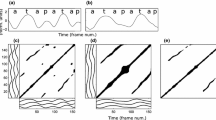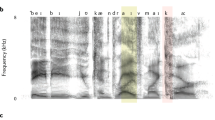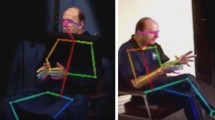Abstract
Speech is a complex oral motor function that involves multiple articulators that need to be coordinated in space and time at relatively high movement speeds. How this is accomplished remains an important and largely unresolved empirical question. From a coordination dynamics perspective, coordination involves the assembly of coordinative units that are characterized by inherently stable coupling patterns that act as attractor states for task-specific actions. In the motor control literature, one particular model formulated by Haken et al. (Biol Cybern 51(5):347–356, 1985) or HKB has received considerable attention in the way it can account for changes in the nature and stability of specific coordination patterns between limbs or between limbs and external stimuli. In this model (and related versions), movement amplitude is considered a critical factor in the formation of these patterns. Several studies have demonstrated its role for bimanual coordination and similar types of tasks, but for speech motor control such studies are lacking. The current study describes a systematic approach to evaluate the impact of movement amplitude and movement duration on coordination stability in the production of bilabial and tongue body gestures for specific vowel–consonant–vowel strings. The vowel combinations that were used induced a natural contrast in movement amplitude at three speaking rate conditions (slow, habitual, fast). Data were collected on ten young adults using electromagnetic articulography, recording movement data from lips and tongue with high temporal and spatial precision. The results showed that with small movement amplitudes there is a decrease in coordination stability, independent from movement duration. These findings were found to be robust across all individuals and are interpreted as further evidence that principles of coupling dynamics operate in the oral motor control system similar to other motor systems and can be explained in terms of coupling mechanisms between neural oscillators (organized in networks) and effector systems. The relevance of these findings for understanding motor control issues in people with speech disorders is discussed as well.





Similar content being viewed by others
Notes
We are aware that repeated measures ANOVA (RMANOVA) and multi-level analysis (ML) are the two default approaches for the analysis of data obtained in repeated measures designs, with the latter approach becoming more popular. However, we refrained from ML-analysis and used RMANOVA because of the restrictions of ML analysis for relatively small sample sizes (Maas and Snijders 2003; Maas and Hox 2005; McNeish and Stapleton 2016) and the fact that the violation of the assumption of compound symmetry can be adjusted by Huynh–Feldt’s epsilon (by downsizing degrees of freedom) as was done in the current analysis (Rietveld and van Hout 2005). As our data analysis file was based on average values across multiple repetitions of the same tokens per condition to use appropriate error degrees of freedom (Max and Onghena 1999), we had no missing data cells for the final analysis, which otherwise would have been a reason to choose the ML approach. A final aspect considered in our choice for using RMANOVA was the availability of partial eta-squared, a well-known index of effect-size.
On request by an anonymous reviewer we also performed a Pearson PM correlation analysis on our data to explore if across the different conditions a relationship between amplitude and relative phase variability could be established. We did indeed find significant negative correlations between SDPHI and both BC amplitudes (r = −0.66, N = 120, p (two-tailed) <0.001) and TB amplitudes (r = −0.60, N = 120, p (two-tailed) <0.001). Since the critical change in relative phase variability occurred specifically at the small amplitudes for the /uːpʊ/ condition, we also performed a Pearson PM correlation analysis without the /uːpʊ/ stimuli, and as expected, the negative correlations values dropped quite a bit, although they were still significant for BC amplitudes (r = −0.43, N = 90, p (two-tailed) < 0.001) and TB amplitudes (r = −0.28, N = 90, p (two-tailed) = 0.007).
References
Ambrose NG, Cox NJ, Yairi E (1997) The genetic basis of persistence and recovery in stuttering. J Speech Lang Hear Res 40(3):567–580
Aoyagi N, Ohashi K, Tomono S, Yamamoto Y (2000) Temporal contribution of body movement to very long-term heart rate variability in humans. Am J Physiol Heart Circ Physiol 278(4):47–54
Batschelet E (1981) Circular statistics in biology. Academic Press, London
Beek PJ, Peper CE, Stegeman DF (1995) Dynamical models of movement coordination. Hum Mov Sci 14(4–5):573–608. doi:10.1016/0167-9457(95)00028-5
Beek PJ, Peper CE, Daffertshofer A (2002) Modeling rhythmic interlimb coordination: beyond the Haken–Kelso–Bunz model. Brain Cogn 48(1):149–165. doi:10.1006/brcg.2001.1310
Boose A, Spieker S, Jentgens C, Dichgans J (1996) Wrist tremor: investigation of agonist-antagonist interaction by means of long-term EMG recording and cross-spectral analysis. Electroencephalogr Clin Neurophysiol Electromyogr Motor Control 101(4):355–363. doi:10.1016/0924-980X(96)95533-2
Bose A, van Lieshout P (2012) Speech-like and non-speech lip kinematics and coordination in aphasia. Int J Lang Commun Disord 47(6):654–672. doi:10.1111/j.1460-6984.2012.00171.x
Bose A, van Lieshout P, Square PA (2007) Word frequency and bigram frequency effects on linguistic processing and speech motor performance in individuals with aphasia and normal speakers. J Neurolinguist 20(1):65–88. doi:10.1016/j.jneuroling.2006.05.001
Byrd D, Saltzman E (1998) Intragestural dynamics of multiple prosodic boundaries. J Phonet 26(2):173–199. doi:10.1006/jpho.1998.0071
De Boer BJ, Peper CE, Ridderikhoff A, Beek PJ (2013) Phase entrainment strength scales with movement amplitude disparity. Mot Control 17(4):399–411
De Poel HJ, Peper CLE, Beek PJ (2007) Handedness-related asymmetry in coupling strength in bimanual coordination: furthering theory and evidence. Acta Physiol (Oxf) 124(2):209–237. doi:10.1016/j.actpsy.2006.03.003
De Poel HJ, Peper CLE, Beek PJ (2009) Disentangling the effects of attentional and amplitude asymmetries on relative phase dynamics. J Exp Psychol Hum Percept Perform 35(3):762–777. doi:10.1037/a0013549
Erickson D (2002) Articulation of extreme formant patterns for emphasized vowels. Phonetica 59(2–3):134–149. doi:10.1159/000066067
Fitts PM (1954) The information capacity of the human motor system in controlling the amplitude of movement. J Exp Psychol 47(6):381–391. doi:10.1037/h0055392
Frayne E, Coulson S, Adams R, Croxson G, Waddington G (2016) Proprioceptive ability at the lips and jaw measured using the same psychophysical discrimination task. Exp Brain Res 234(6):1679–1687. doi:10.1007/s00221-016-4573-0
Fuchs A, Jirsa VK, Haken H, Kelso JAS (1996) Extending the HKB model of coordinated movement to oscillators with different eigenfrequencies. Biol Cybern 74(1):21–30. doi:10.1007/BF00199134
Goldstein L, Pouplier M, Chen L, Saltzman E, Byrd D (2007) Dynamic action units slip in speech production errors. Cognition 103(3):386–412. doi:10.1016/j.cognition.2006.05.010
Goldstein L, Nam H, Saltzman E, Chitoran I (2009) Coupled oscillator planning model of speech timing and syllable structure. In: Fant G, Fujisaki H, Chen J (eds) Frontiers in phonetics and speech science. The Commercial Press, Beijing, pp 239–250
Guiard Y, Olafsdottir HB (2011) On the measurement of movement difficulty in the standard approach to fitts’ law. PLoS One 6(10):e24389. doi:10.1371/journal.pone.0024389
Haken H (1977) Synergetics. Springer, Berlin. doi:10.1007/978-3-642-66784-8
Haken H, Kelso JAS, Bunz H (1985) A theoretical model of phase transitions in human hand movements. Biol Cybern 51(5):347–356. doi:10.1007/BF00336922
Hasegawa-Johnson M (1997) Electromagnetic exposure safety of the carstens articulograph AG100. http://www.ifp.illinois.edu/~hasegawa/emma/index.html. Accessed 12 Aug 2016
Hatsopoulos NG (1996) Coupling the neural and physical dynamics in rhythmic movements. Neural Comput 8(3):567–581
Hillenbrand J, Getty LA, Clark MJ, Wheeler K (1995) Acoustic characteristics of American English vowels. J Acoust Soc Am 97(5 Pt 1):3099–3111
Jirsa VK, Haken H (1997) A derivation of a macroscopic field theory of the brain from the quasi-microscopic neural dynamics. Phys D 99(4):503–526. doi:10.1016/S0167-2789(96)00166-2
Kandel E (2013) Principles of neural science, 5th edn. McGraw Hill Professional, New York
Kay SM (1988) Modern spectral estimation: theory and application. Prentice-Hall, Upper Saddle River
Kelso JA (1984) Phase transitions and critical behavior in human bimanual coordination. Am J Physiol 246(6 Pt 2):R1000–R1004
Kelso JAS (1986) Pattern formation in speech and limb movements involving many degrees of freedom. Exp Brain Res SUPPL. 15:105–128
Kelso J (1995) Dynamic patterns: the self-organization of brain and behavior. MIT Press, Cambridge
Kelso JAS, Tuller B (1983) “Compensatory articulation” under conditions of reduced afferent information: a dynamic formulation. J Speech Hear Res 26(2):217–224
Kelso JAS, Tuller B (1984) Converging evidence in support of common dynamical principles for speech and movement coordination. Am J Physiol Regul Integr Comp Physiol 246(6):R928–R935
Kelso JAS, Bateson EV, Saltzman EL, Kay B (1985) A qualitative dynamic analysis of reiterant speech production: phase portraits, kinematics, and dynamic modeling. J Acoust Soc Am 77(1):266–280. doi:10.1121/1.392268
Kelso JAS, Saltzman EL, Tuller B (1986) The dynamical perspective on speech production: data and theory. J Phonet 14:29–59
Kent RD (2004) The uniqueness of speech among motor systems. Clin Linguist Phonet 18(6–8):495–505
Laboissière R, Lametti DR, Ostry DJ (2009) Impedance control and its relation to precision in orofacial movement. J Neurophysiol 102(1):523–531. doi:10.1152/jn.90948.2008
Lamb PF, Stöckl M (2014) On the use of continuous relative phase: review of current approaches and outline for a new standard. Clin Biomech 29(5):484–493. doi:10.1016/j.clinbiomech.2014.03.008
Lametti DR, Nasir SM, Ostry DJ (2012) Sensory preference in speech production revealed by simultaneous alteration of auditory and somatosensory feedback. J Neurosci 32(27):9351–9358. doi:10.1523/JNEUROSCI.0404-12.2012
Lammert AC, Shadle CH, Narayanan SS, Quatieri TF (2016) Investigation of speed-accuracy tradeoffs in speech production using real-time magnetic resonance imaging (vol 8, pp 460–464) Presented at the proceedings of the annual conference of the international speech communication association, INTERSPEECH, ISCA. doi:10.21437/Interspeech.2016-157
Lee J, Shaiman S, Weismer G (2016) Relationship between tongue positions and formant frequencies in female speakers (vol 139, pp 426–440) Presented at the Journal of the Acoustical Society of America, Acoustical Society of America—ASA. doi:10.1121/1.4939894
Maas CJM, Hox JJ (2005) Sufficient sample sizes for multilevel modeling. Methodology 1(3):86–92. doi:10.1027/1614-2241.1.3.86
Maas CJM, Snijders TAB (2003) The multilevel approach to repeated measures for complete and incomplete data. Qual Quant 37(1):71–89. doi:10.1023/A:1022545930672
Max L, Onghena P (1999) Some issues in the statistical analysis of completely randomized and repeated measures designs for speech, language, and hearing research. J Speech Lang Hear Res 42(2):261–270. doi:10.1044/jslhr.4202.261
McComas AJ (1998) Oro-facial muscles: internal structure, function and ageing. Gerodontology 15(1):3–14
McNeish DM, Stapleton LM (2016) The effect of small sample size on two-level model estimates: a review and illustration. Educ Psychol Rev 28(2):295–314. doi:10.1007/s10648-014-9287-x
Mefferd AS, Green JR (2010) Articulatory-to-acoustic relations in response to speaking rate and loudness manipulations. J Speech Lang Hear Res 53(5):1206–1219. doi:10.1044/1092-4388(2010/09-0083)
Morasso PG, Sanguineti V, Frisone F, Perico L (1998) Coordinate-free sensorimotor processing: computing with population codes. Neural Networks 11(7–8):1417–1428. doi:10.1016/S0893-6080(98)00065-3
Morrison S, Newell KM (2000) Limb stiffness and postural tremor in the arm. Mot Control 4(3):293–315
Namasivayam AK, Van Lieshout P (2011) Speech motor skill and stuttering. J Mot Behav 43(6):477–489. doi:10.1080/00222895.2011.628347
Namasivayam AK, Van Lieshout P, De Nil L (2008) Bite-block perturbation in people who stutter: immediate compensatory and delayed adaptive processes. J Commun Disord 41(4):372–394. doi:10.1016/j.jcomdis.2008.02.004
Namasivayam AK, Van Lieshout P, McIlroy WE, De Nil L (2009) Sensory feedback dependence hypothesis in persons who stutter. Hum Mov Sci 28(6):688–707. doi:10.1016/j.humov.2009.04.004
Neto Henriques R, Van Lieshout P (2013) A comparison of methods for decoupling tongue and lower lip from jaw movements in 3D articulography. J Speech Lang Hear Res 56(5):1503–1516. doi:10.1044/1092-4388(2013/12-0016)
Neufeld C, Van Lieshout P (2014) Tongue kinematics in palate relative coordinate spaces for electro-magnetic articulography. J Acoust Soc Am 135(1):352–361. doi:10.1121/1.4836515
Peper CE, Beek PJ (1998a) Are frequency-induced transitions in rhythmic coordination mediated by a drop in amplitude? Biol Cybern 79(4):291–300
Peper CE, Beek PJ (1998b) Distinguishing between the effects of frequency and amplitude on interlimb coupling in tapping a 2:3 polyrhythm. Exp Brain Res 118(1):78–92. doi:10.1007/s002210050257
Peper CE, Beek PJ (1999) Modeling rhythmic interlimb coordination: the roles of movement amplitude and time delays. Hum Mov Sci 18(2–3):263–280. doi:10.1016/S0167-9457(99)00011-1
Peper CE, Daffertshofer A, Beek PJ (2004a) Dynamical models of rhythmic interlimb coordination: relating pattern (in)stability to neural processes and effector properties. In: Swinnen SP, Duysens J (eds) Neuro-behavioral determinants of interlimb coordination. Springer, pp 297–323
Peper CLE, Ridderikhoff A, Daffertshofer A, Beek PJ (2004b) Explanatory limitations of the HKB model: incentives for a two-tiered model of rhythmic interlimb coordination. Hum Mov Sci 23(5):673–697. doi:10.1016/j.humov.2004.10.007
Peper CLE, De Boer BJ, De Poel HJ, Beek PJ (2008) Interlimb coupling strength scales with movement amplitude. Neurosci Lett 437(1):10–14. doi:10.1016/j.neulet.2008.03.066
Perkell JS, Cohen MH, Svirsky MA, Matthies ML, Garabieta I, Jackson MTT (1992) Electromagnetic midsagittal articulometer systems for transducing speech articulatory movements. J Acoust Soc Am 92(6):3078–3096. doi:10.1121/1.404204
Peterson GE, Barney HL (1952) Control methods used in a study of the vowels. J Acoust Soc Am 24(2):175–184. doi:10.1121/1.1906875
Portney LG, Watkins MP (1993) Foundations of clinical research: applications to practice. Appleton and Lange, Stamford
Ridderikhoff A, Peper CLE, Beek PJ (2005) Unraveling interlimb interactions underlying bimanual coordination. J Neurophysiol 94(5):3112–3125. doi:10.1152/jn.01077.2004
Rietveld T, van Hout R (2005) Statistics in language research. Walter de Gruyter, Berlin
Saltzman E, Byrd D (2000) Task-dynamics of gestural timing: phase windows and multifrequency rhythms. Hum Mov Sci 19(4):499–526. doi:10.1016/S0167-9457(00)00030-0
Saltzman EL, Munhall KG (1989) A dynamical approach to gestural patterning in speech production. Ecol Psychol 1(4):333–382. doi:10.1207/s15326969eco0104_2
Saltzman E, Lofqvist A, Kay B, Kinsella-Shaw J, Rubin P (1998) Dynamics of intergestural timing: a perturbation study of lip-larynx coordination. Exp Brain Res 123(4):412–424. doi:10.1007/s002210050586
Schönle PW, Gräbe K, Wenig P, Höhne J, Schrader J, Conrad B (1987) Electromagnetic articulography: use of alternating magnetic fields for tracking movements of multiple points inside and outside the vocal tract. Brain Lang 31(1):26–35. doi:10.1016/0093-934X(87)90058-7
Serrien DJ, Swinnen SP (1998) Load compensation during homologous and non-homologous coordination. Exp Brain Res 121(3):223–229
Slis A, van Lieshout P (2013) The effect of phonetic context on speech movements in repetitive speech. J Acoust Soc Am 134(6):4496–4507. doi:10.1121/1.4828834
Slis A, van Lieshout P (2016) The effect of auditory information on patterns of intrusions and reductions. J Speech Lang Hear Res 59(3):430–445. doi:10.1044/2015_JSLHR-S-14-0258
Smits-Engelsman B, Van Galen G, Duysens J (2002) The breakdown of Fitts’ law in rapid, reciprocal aiming movements. Exp Brain Res 145(2):222–230. doi:10.1007/s00221-002-1115-8
Sternad D, Saltzman EL, Turvey MT (1998) Interlimb coupling in a simple serial behavior: a task dynamic approach. Hum Mov Sci 17(3):393–433
Swinnen SP (2002) Intermanual coordination: from behavioural principles to neural-network interactions. Nat Rev Neurosci 3(5):348–359. doi:10.1038/nrn807
Tilsen S (2009) Multi timescale dynamical interactions between speech rhythm and gesture. Cogn Sci 33(5):839–879. doi:10.1111/j.1551-6709.2009.01037.x
Tilsen S, Arvaniti A (2013) Speech rhythm analysis with decomposition of the amplitude envelope: characterizing rhythmic patterns within and across languages. J Acoust Soc Am 134(1):628–639. doi:10.1121/1.4807565
Tilsen S, Goldstein L (2012) Articulatory gestures are individually selected in production. J Phonet 40(6):764–779. doi:10.1016/j.wocn.2012.08.005
Turvey MT (1990) Coordination. Am Psychol 45(8):938–953. doi:10.1037/0003-066X.45.8.938
Van Lieshout PHHM (2012) Dynamical systems theory and its application in speech. In: Maassen B, Kent R, Peters H, Van Lieshout P, Hulstijn W (eds) Speech motor control in normal and disordered speech. Oxford University Press, Oxford, pp 51–82
Van Lieshout PHHM (2015) Jaw and lips. In: Redford MA (ed) The handbook of speech production. Wiley, Hoboken, pp 79–108. doi:10.1002/9781118584156.ch5
Van Lieshout PHHM, Moussa W (2000) The assessment of speech motor behavior using electromagnetic. Phonetician 81:9–22
van Lieshout P, Neufeld C (2014) Coupling dynamics interlip coordination in lower lip load compensation. J Speech Lang Hear Res 57(2):S597–S615. doi:10.1044/2014_JSLHR-S-12-0207
Van Lieshout PHHM, Rutjens CAW, Spauwen PHM (2002) The dynamics of interlip coupling in speakers with a repaired unilateral cleft-lip history. J Speech Lang Hear Res 45(1):5–19. doi:10.1044/1092-4388(2002/001)
Van Lieshout PHHM, Hulstijn W, Peters HFM (2004) Searching for the weak link in the speech production chain of people who stutter: a motor skill approach. In: Maassen B, Kent R, Peters H, Van Lieshout P, Hulstijn W (eds) Speech motor control in normal and disordered speech. Oxford University Press, Oxford, pp 313–356
Van Lieshout PHHM, Bose A, Square PA, Steele CM (2007) Speech motor control in fluent and dysfluent speech production of an individual with apraxia of speech and Broca’s aphasia. Clin Linguist Phonet 21(3):159–188. doi:10.1080/02699200600812331
Walsh B, Mettel KM, Smith A (2015) Speech motor planning and execution deficits in early childhood stuttering. J Neurodev Disord 7(1):1–12. doi:10.1186/s11689-015-9123-8
Wang J, Green JR, Samal A, Yunusova Y (2013) Articulatory distinctiveness of vowels and consonants: a data-driven approach. J Speech Lang Hear Res 56(5):1539–1551. doi:10.1044/1092-4388(2013/12-0030)
Westbury JR (1994) On coordinate systems and the representation of articulatory movements. J Acoust Soc Am 95(4):2271–2273. doi:10.1121/1.408638
Williamson MM (1998) Neural control of rhythmic arm movements. Neural Netw 11(7–8):1379–1394. doi:10.1016/S0893-6080(98)00048-3
Acknowledgements
We wish to thank Dr. Toni Rietveld for providing statistical advice for data analysis. We also thank Dr. Lieke Peper for her feedback on a previous version of this manuscript. The study reported in this paper was supported by the Natural Sciences and Engineering Research Council (NSERC) and funding from the Canada Research Chairs program, both awarded to the author.
Author information
Authors and Affiliations
Corresponding author
Rights and permissions
About this article
Cite this article
van Lieshout, P.H.H.M. Coupling dynamics in speech gestures: amplitude and rate influences. Exp Brain Res 235, 2495–2510 (2017). https://doi.org/10.1007/s00221-017-4983-7
Received:
Accepted:
Published:
Issue Date:
DOI: https://doi.org/10.1007/s00221-017-4983-7




